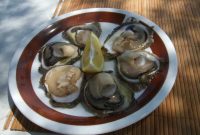Is Croatian food tasty? How much does a meal cost in Croatia? Advantages and Disadvantages
Croatian food
Is Croatian food tasty?
Yes, folks who appreciate Mediterranean and Balkan cuisines frequently describe Croatian food as excellent and flavorful. Croatian food is renowned for its use of locally grown, fresh ingredients as well as a wide range of regional flavors and influences.
Popular Croatian dishes include the following:
- Ćevapi: Small sausages made from grilled minced meat (often a blend of beef and lamb), flatbread, and an ajvar-based sauce are common accompaniments.
- Peka: A wonderful and soft dinner is produced by slow-cooking meat, veggies, and occasionally potatoes in this classic Croatian cuisine.
- Buzara: A specialty of the Croatian coast is seafood, frequently shellfish like mussels or shrimp, cooked in a white wine, garlic, and parsley sauce.
- Pasticada: a red wine and spice-marinated beef stew that is cooked slowly and is frequently served with gnocchi or pasta.
- Risotto: risotto prepared in the Croatian style with a variety of ingredients, including shrimp, mushrooms, or asparagus.
- Octopus Salad (Salata od Hobotnice): Octopus, potatoes, olive oil, garlic, and parsley are combined to make a light salad.
- Soparnik: a popular Dalmatian-style savory pie from Croatia prepared with chard, onions, and olive oil.
- Strukli: a pastry from the Zagorje region that is filled with sour cream and cottage cheese.
Fresh seafood, fruits, vegetables, olive oil, and aromatic herbs are frequently included in Croatian cuisine. Regional differences in flavor include coastal locations with a strong Mediterranean influence and inland places with more classic Central European flavors. In the end, your palette and personal preferences will determine if you find Croatian food to be appetizing.

Advantages and Disadvantages:
Like any cuisine, Croatian food has benefits and drawbacks. These elements can change depending on cultural, culinary, and individual preferences. The following are some pros and drawbacks of Croatian cuisine that are frequently cited:
Advantages:
- Fresh and Locally Sourced Ingredients: Fresh, regionally obtained ingredients are frequently emphasized in Croatian cooking, which improves the overall standard and flavor of the dishes.
- Mediterranean Influence: Because of Croatia’s position on the Mediterranean coast, its food focuses on healthy ingredients like olive oil, fresh seafood, vegetables, and aromatic herbs.
- Diverse Dishes: A vast array of foods, including grilled meats, seafood, stews, pastries, and salads, are available in Croatian cuisine, offering a wide range of flavors and possibilities to suit varied palates.
- Rich Flavors: Croatian cuisine is renowned for its robust flavor profiles, which are frequently enhanced by the use of a variety of spices, herbs, and other condiments.
- Culinary Heritage: Many dishes in Croatian cuisine have been handed down through the generations, preserving the nation’s cultural history and being strongly anchored in centuries-old customs.
- Balanced Diet: A well-rounded and balanced diet is encouraged by the frequent use of a variety of proteins, carbs, vegetables, and fruits in Croatian meals.
Disadvantages:
- Heavy on Meat and Dairy: Traditional Croatian foods may not be ideal for anyone following a low-meat or vegetarian/vegan diet because they tend to be high in meat (particularly red meat) and dairy ingredients.
- High in Calories and Fat: Traditional Croatian cuisine like stews and fried foods can include a lot of calories and fat and may not be suitable for a diet low in fat or calories.
- Processed Foods: Due to their potential high quantities of sugars, salt, and harmful fats, processed and fast foods may not be the healthiest nutritional options in Croatia as a result of modernization and urbanization.
- Limited Vegetarian and Vegan Options: Although vegetarian and vegan meals are present in Croatian cuisine, they might not be as common or as varied as in certain other cuisines. For those who have certain dietary preferences or limits, this can be difficult.
- Seasonal Variability: Traditional Croatian cuisines frequently use seasonal ingredients, which can make them scarce or bland at certain seasons of the year.
Ultimately, one’s personal preferences, dietary requirements, and general lifestyle choices will determine whether or not Croatian cuisine is advantageous. When exploring and savoring any dish, it’s crucial to keep these things in mind.

How much does a meal cost in Croatia?
Depending on the type of restaurant, location (coastal locations tend to be more expensive), and whether you’re eating in a high-end restaurant, a mid-range restaurant, or a more affordable alternative, the price of a meal in Croatia can vary greatly. Here is an idea of what you might expect to pay for meals in Croatia:
- Budget-Friendly Restaurants: A cheap dinner can be had for 40 to 100 Croatian Kuna (HRK), which is equivalent to around 6 to 15 US dollars, in neighborhood restaurants, cafes, or bakeries.
- Mid-Range Restaurants: A three-course meal in a mid-range restaurant should cost between 100 and 250 HRK (15 and 40 USD).
- Fine Dining or High-End Restaurants: Prices for a multi-course lunch with wine can range from 250 HRK to several hundred HRK (40 USD and higher) per person at a fine dining establishment.
- Street Food and Fast Food: Fast food and street food can be had at reasonable prices; a sandwich or slice of pizza runs between 20 to 50 HRK (3 to 8 USD).
- Coffee and Drinks: Depending on the location and quality of coffee, a cup of coffee in a cafe normally costs between 10 and 20 HRK (1.5 and 3 USD).
- Grocery Store or Supermarket: If you decide to buy groceries and cook your own meals, you need budget between 150 and 300 HRK (25 and 50 USD) per week for the necessities.

For the most recent information on prices in Croatia, it is advised to check more recent sources or consult travel guides since prices may have changed since my last update. Prices can also change during the busiest travel seasons and in well-known tourist locations.




